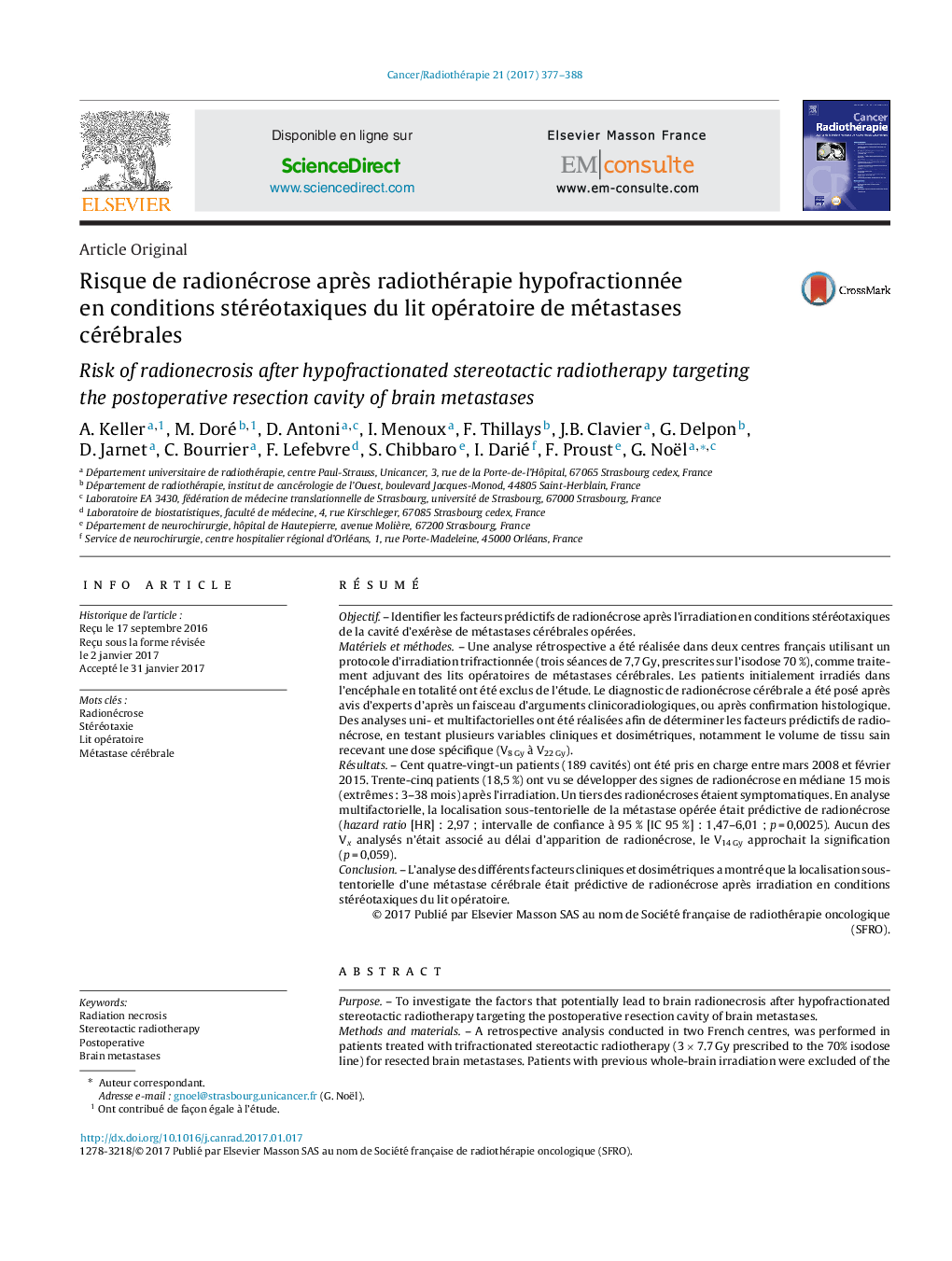| کد مقاله | کد نشریه | سال انتشار | مقاله انگلیسی | نسخه تمام متن |
|---|---|---|---|---|
| 5525861 | 1401502 | 2017 | 12 صفحه PDF | دانلود رایگان |

RésuméObjectifIdentifier les facteurs prédictifs de radionécrose après l'irradiation en conditions stéréotaxiques de la cavité d'exérèse de métastases cérébrales opérées.Matériels et méthodesUne analyse rétrospective a été réalisée dans deux centres français utilisant un protocole d'irradiation trifractionnée (trois séances de 7,7 Gy, prescrites sur l'isodose 70 %), comme traitement adjuvant des lits opératoires de métastases cérébrales. Les patients initialement irradiés dans l'encéphale en totalité ont été exclus de l'étude. Le diagnostic de radionécrose cérébrale a été posé après avis d'experts d'après un faisceau d'arguments clinicoradiologiques, ou après confirmation histologique. Des analyses uni- et multifactorielles ont été réalisées afin de déterminer les facteurs prédictifs de radionécrose, en testant plusieurs variables cliniques et dosimétriques, notamment le volume de tissu sain recevant une dose spécifique (V8 Gy à V22 Gy).RésultatsCent quatre-vingt-un patients (189 cavités) ont été pris en charge entre mars 2008 et février 2015. Trente-cinq patients (18,5 %) ont vu se développer des signes de radionécrose en médiane 15 mois (extrêmes : 3-38 mois) après l'irradiation. Un tiers des radionécroses étaient symptomatiques. En analyse multifactorielle, la localisation sous-tentorielle de la métastase opérée était prédictive de radionécrose (hazard ratio [HR] : 2,97 ; intervalle de confiance à 95 % [IC 95 %] : 1,47-6,01 ; p = 0,0025). Aucun des Vx analysés n'était associé au délai d'apparition de radionécrose, le V14 Gy approchait la signification (p = 0,059).ConclusionL'analyse des différents facteurs cliniques et dosimétriques a montré que la localisation sous-tentorielle d'une métastase cérébrale était prédictive de radionécrose après irradiation en conditions stéréotaxiques du lit opératoire.
PurposeTo investigate the factors that potentially lead to brain radionecrosis after hypofractionated stereotactic radiotherapy targeting the postoperative resection cavity of brain metastases.Methods and materialsA retrospective analysis conducted in two French centres, was performed in patients treated with trifractionated stereotactic radiotherapy (3Â ÃÂ 7.7Â Gy prescribed to the 70% isodose line) for resected brain metastases. Patients with previous whole-brain irradiation were excluded of the analysis. Radionecrosis was diagnosed according to a combination of criteria including clinical, serial imaging or, in some cases, histology. Univariate and multivariate analyses were performed to determine the predictive factors of radionecrosis including clinical and dosimetric variables such as volume of brain receiving a specific dose (V8Â Gy-V22Â Gy).ResultsOne hundred eighty-one patients, with a total of 189 cavities were treated between March 2008 and February 2015. Thirty-five patients (18.5%) developed radionecrosis after a median follow-up of 15 months (range: 3-38 months) after hypofractionated stereotactic radiotherapy. One third of patients with radionecrosis were symptomatic. Multivariate analysis showed that infra-tentorial location was predictive of radionecrosis (hazard ratio [HR]: 2.97; 95% confidence interval [95% CI]: 1.47-6.01; PÂ =Â 0.0025). None V8Â Gy-V22Â Gy was associated with appearance of radionecrosis, even if V14Â Gy trended toward significance (PÂ =Â 0.059).ConclusionAnalysis of patients and treatment variables revealed that infratentorial location of brain metastases was predictive for radionecrosis after hypofractionated stereotactic radiotherapy for postoperative resection cavities.
Journal: Cancer/Radiothérapie - Volume 21, Issue 5, August 2017, Pages 377-388